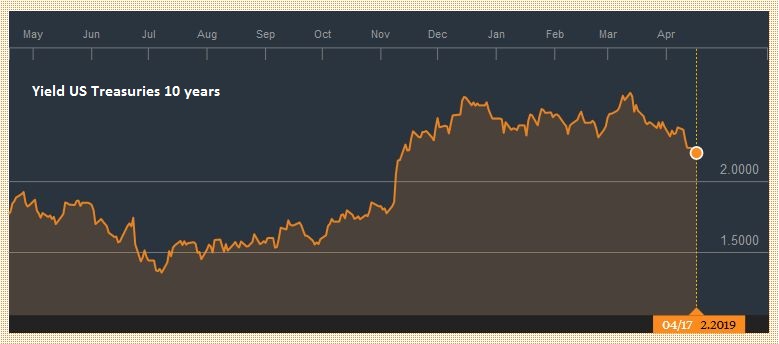Summary: Monetary policy is off the table for at least the next two months. Several fiscal issues are coming to a head. Despite the GOP majority in Congress and White House, brinkmanship cannot be ruled out. The Federal Reserve hiked rates in March. Whatever gradual hikes mean, it seems to preclude moves in back-to-back meetings. There are two chances of a May hike: Slim and none and Slim left town. June is a different story. Anticipating the economy finding better traction, and a non-disruptive conclusion of the French presidential election, we continue to think a June hike is the most likely scenario. Bloomberg’s calculation puts the odds of a June hike near 47% down from closer to 56% a week ago. The CME puts the chances at nearly 55%, down from 59% at the end of last week. So far this week, the implied yield on the June Fed funds futures contract has risen 1.5 bp to 97 bp. The focus may shift back to fiscal policy. There are two large outstanding issues. The debt ceiling, which was reinstated March 15. The second is spending authority, which expires near the end of the month, just ahead of Trump’s 100th day as President. The imposition of the debt ceiling forces the US Treasury to take extraordinary measures.
Topics:
Marc Chandler considers the following as important: Featured, Fiscal, FX Trends, newslettersent, US, USD
This could be interesting, too:
Nachrichten Ticker - www.finanzen.ch writes Die Performance der Kryptowährungen in KW 9: Das hat sich bei Bitcoin, Ether & Co. getan
Nachrichten Ticker - www.finanzen.ch writes Wer verbirgt sich hinter der Ethereum-Technologie?
Marc Chandler writes March 2025 Monthly
Mark Thornton writes Is Amazon a Union-Busting Leviathan?
Summary:
Monetary policy is off the table for at least the next two months.
Several fiscal issues are coming to a head.
Despite the GOP majority in Congress and White House, brinkmanship cannot be ruled out.
The Federal Reserve hiked rates in March. Whatever gradual hikes mean, it seems to preclude moves in back-to-back meetings. There are two chances of a May hike: Slim and none and Slim left town.
June is a different story. Anticipating the economy finding better traction, and a non-disruptive conclusion of the French presidential election, we continue to think a June hike is the most likely scenario. Bloomberg’s calculation puts the odds of a June hike near 47% down from closer to 56% a week ago. The CME puts the chances at nearly 55%, down from 59% at the end of last week. So far this week, the implied yield on the June Fed funds futures contract has risen 1.5 bp to 97 bp.
The focus may shift back to fiscal policy. There are two large outstanding issues. The debt ceiling, which was reinstated March 15. The second is spending authority, which expires near the end of the month, just ahead of Trump’s 100th day as President.
| The imposition of the debt ceiling forces the US Treasury to take extraordinary measures. An analyst who previously worked at the Federal Reserve suggests that among the measures are the boosting of cash balances, which in turn drains the excess reserves and is one of the factors that have boosted the cross-currency basis. This, in turn, is a drag on the US dollar. |
US Treasuries Yield 10 years, April 2016 - 2017(see more posts on U.S. Treasuries, ) Source: Bloomberg.com - Click to enlarge |
Often the increase in the debt ceiling, which allows the US government to pay for what it was authorized to spend is a source of negotiation with Congress. Many people thought that with one party in control of both the legislative and executive branches, that this would not be a battle this time. However, as we have seen (e.g. health care reform), the Republican Party, like all modern parties, are a coalition of disparate interest.
It has been the legislative branch (the House of Representatives) that uses the debt ceiling to extract concessions from the President, but this time, it appears that the executive branch may threaten Congress with it. Director of the Office of Management and Budget Mulvaney, one of the founders of the Freedom Caucus (formerly known as the Tea Party) has been talking about prioritizing debt servicing this week.
In addition to the debt ceiling issue are the spending authorization and the budget for the last several months of the current fiscal year. Under Obama, a formal agreement on the budget proved elusive. Instead, the government ran on continuing resolutions. Trump has proposed a budget for the remainder of the fiscal year, which included $30 bln increase in security (defense and homeland security), an $18 bln cut in non-defense spending, and funding for the infamous wall on the border with Mexico.
Trump’s proposals look to run into opposition in the Senate. Not only have several Republicans leaders rejected some of the cuts in non-defense spending proposed by Trump, but many Democrats will not support spending money on the wall. The power to filibuster judicial nominees has been gutted, but it is still a viable parliamentary maneuver on other issues, including the budget.
The takeaway point is that the monetary policy is on hold for at least the next two months (June 14th FOMC meeting with updated forecasts and confidence fans). Fiscal policy moves to the fore. There are three major issues: the debt ceiling, the budget for the remainder of the fiscal year, and spending authorization. The markets seem fairly relax over the prospects of new brinkmanship within the Republican Party, between the executive and legislative branches, and/or with the opposition Democrats. With the Trump Administration governing by executive orders, with the judicial branch blocking travel ban, and disputes within the Republican Party blocking the legislative agenda, many see the lower Treasury yields as at least in part a reflection of doubts about the extent of the tax reform and infrastructure program being able to boost growth.
Tags: #USD,Featured,Fiscal,newslettersent,US
